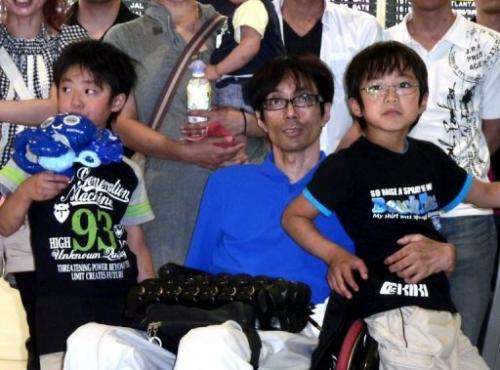Disabled Japanese man begins robo-suit adventure

A disabled Japanese man on Friday embarked on an ambitious trip that will take him to a mediaeval French World Heritage site with the help of a cutting-edge robotic suit.
Seiji Uchida, 49, who lost the ability to walk in a car accident 28 years ago, said his trip to the picturesque abbey of Mont Saint Michel, set on a rocky islet in Normandy, will be only the beginning of his dream.
"Right now, I cannot stand on my own feet without help," said Uchida at Tokyo's Narita airport before his departure to France.
"But I will never give up on my hope of someday walking on my own feet, no matter how many years it would take."
In a project planned to take place Tuesday, Uchida -- paralysed from his waist down and in one hand -- will be carried up the hill of Mont Saint Michel by a man wearing a robot suit, called the Hybrid Assistive Limb (HAL).
Battery-powered HAL, which detects muscle impulses to anticipate and support the user's body movements, was originally designed to help the elderly with mobility and manual work and to assist hospital carers in lifting patients.

The specially-designed exoskeleton suit will enable Uchida's carrier to bear an 80 kilogramme (176 pound) load, whereas Uchida only weighs 45 kilogrammes.
The suit, which works like an exoskeleton and amplifies the muscle power of its wearer's legs, has a pannier that Uchida will hold onto.
A full-body model of HAL, being developed by Tsukuba University professor Yoshiyuki Sankai, assists both arms and legs, and allows users to carry a load of up to 70 kilogrammes (154 pounds) with one arm.
Uchida and a support team used an earlier version of the suit in an unsuccessful attempt to conquer the 4,164-metre (13,661-foot) Breithorn peak in Switzerland in 2006, when climbers wearing the robo-suits carried Uchida.
Uchida said he wants to visit the rocky tidal island of Mont Saint Michel, where a steep and narrow trail leads to an abbey and former fortress, to "prove that it is possible for disabled people to visit the world's historic sites without relying on facilities like elevators", he said.
(c) 2011 AFP


















